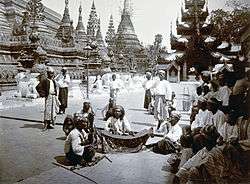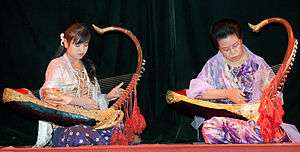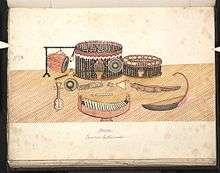Music of Myanmar
| Part of a series on the |
| Culture of Myanmar |
|---|
 |
| History |
| People |
| Cuisine |
|
Festivals |
| Religion |
| Literature |
|
Music and performing arts |
|
Monuments |
|
The music of Burma (or Myanmar) has similarities with and is related to many other musical traditions in the region, including Chinese music and Thai music.
Traditional music

Traditional music from Burma is melodious, generally without harmony, and usually in 4/4 time (na-yi-se) or 2/4 (wa-let-se) or 8/16 (wa-let-a-myan). There are "the segments combined into patterns, combined into verses, combined into songs [that] make Burmese music a multileveled hierarchical system...The Burmese musician manipulates the various levels of the hierarchy to create the song..." (Becker 1969, p. 272)
Classical traditions
Orthodox Theravada Buddhism frowns upon music as being decadent. Despite this cultural backdrop, the Burmese monarchy as well as the infusion of different regional music styles, have created several classical traditions of Burmese music. The oldest influences may perhaps come from China, which shares a similar pentatonic musical scale as classical Burmese music.[1] Other influences include Mon music (called Talaing than or "sounds of the Talaing [Mon]"), particularly in the Mahagita (မဟာဂိတ), the complete body of classical Burmese music.[2][3]
A prevailing one is called Yodaya (ယိုးဒယား), which is essentially a class of Burmese adaptations to songs accompanied with the saung gauk and come from the Ayutthaya kingdom (modern-day Thailand) during the reigns of Bayinnaung (1551–1581) and Hsinbyushin (1753–1776), which brought back a variety of cultural traditions including the Ramayana.[1] The primary indigenous form is called thachin (သချင်း).
Burmese classical music ensembles can be divided into outdoor and indoor ensembles. The outdoor musical ensemble is the sidaw (စည်တော်); also called sidawgyi (စည်တော်ကြီး), which was an outdoor ensemble in royal courts used to mark important ceremonial functions like the royal ploughing ceremony.[2] It consists of a hnegyi (နှဲကြီး), a large double reed pipe and sidaw (စည်တော်), a pair of ceremonial drums, as well as the si (စည်း) and wa (ဝါး), a bell and clapper and the gandama, a double-headed drum. Today, sidaw music is played at festivals. Other instruments used in classical music include the saung (a harp) and pattala (a xylophone). The indoor form is the chamber music ensemble, which is basically a female singer accompanied by a traditional ensemble consisting of the saung (စောင်း), pattala (ပတ္တလား), migyaung (မိကျောင်း, a zither), palwe (ပလွေ, a flute) and in the past, included the tayaw (တယော, a fiddle) and hnyin (a small mouth organ).[4]
Mahagita

Translated as "great music" in Pali, the Mahagita is an extensive collection of Burmese classical songs, called thachin gyi. The collection is divided into several different types of songs, including the following: kyo, bwe, thachin gan, the oldest repertoires; pat pyo, royal court music; lwan chin, songs of longing; lay dway than gat; myin gin, music that makes horses dance; nat chin, songs used to worship the nat, Burmese spirits; yodaya, music introduced from Ayutthaya, Talaing than, music adapted from the Mon people and bole, songs of sorrow.[3]
Folk traditions
Burmese music includes a variety of folk traditions. A distinct form called the byaw (ဗျော), is often played at religious festivals and is sung to the beat of a long and thin drum, with occasional interruptions by the beating of a larger drum.[5]
The traditional folk ensemble, typically used in the nat pwe, Burmese theatre and art, and festivals is called the hsaing waing (ဆိုင်းဝိုင်း). Although its origin is unknown, it is believed to have come from the Ayuthaya kingdom, or in the least been heavily influenced by the Ayuthaya gong and drum ensembles in the 18th century through repeated invasions by the Konbaung dynasty and has many similarities to other Southeast Asian ensembles.[2] The ensemble is made up of a series of drums and gongs, including the centerpieces, which are the hne (double reed pipe) and pat waing or hsaing wan (ဆိုင်းဝိုင်း, set of 21 tuned drums in a circle).[2]
Other instruments in this ensemble include the kyi waing (ကြေးဝိုင်း, small bronze gongs in a circular frame) and maung hsaing (မောင်းဆိုင်း, larger bronze gongs in a rectangular frame), as well as the si and wa (bell and clapper) and the recent addition of the chauk lone bat (a group of six drums which have gained currency since the early 20th century).[2] Hsaing waing music, however, is atypical in Southeast Asian music, characterised by sudden shifts in rhythm and melody as well as change in texture and timbre.[6]
Popular music
Early beginnings
Western music gained much popularity in Burma starting from the 1930s. Despite government intervention at times, especially during the socialist era, popular Burmese music has become considerably influenced by Western music, which consists of popular Western songs rendered in Burmese and pop music similar to other Asian pop tunes.[6] Classical music was also introduced during the British occupation. Cult folk musician Nick Drake was born in Burma during British rule.
Rock music, called stereo in Burmese, has been a popular form of music since the 1980s, having been introduced in the 1960s.[7] Pop music emerged in the 1970s and was banned by state-run radio stations. However, many artists circumvented this censorship by producing albums in private studios and releasing them in music production shops.[8] During the socialist era, musicians and artists were subject to censorship by the Press Scrutiny Board and Central Registration Board, as well as laws like the State Protection Law.[8] During this period, the arrival of various bands including the influential Thabawa Yinthwenge (The Wild Ones), which included lead singer Sai Htee Saing, an ethnic Shan in 1973, paved the way for ethnic minority musicians to gain visibility in the Burmese music industry.[8] Sai Kham Leik is a well known composer associated with The Wild Ones. Other contemporary singers were Khin Maung Toe, Kaiser, Hlwan Moe, Htoo Ein Thin, Soe Lwin Lwin, Saung Oo Hlaing, Lay Phyu, May Sweet, Maykhala and Connie.
1980s-1990s
During the 8888 Uprising, restrictions loosened and many artists began writing music with themes of freedom and democracy. However, after the State Law and Order Restoration Council usurped power in 1988, the Press Scrutiny Board was reformed to censor specific political and social issues, including poverty, the sex trade, democracy and human rights. The Myanmar Music Asiayon (MMA) was established by the SLORC to further censor Burmese-produced music. Popular musicians including Zaw Win Htut and Sai Htee Saing have produced propaganda albums written by military officers such as Mya Than San.[8]
Hip hop and rap emerged in the late 1990s and is now the prevailing genre of music among Burmese youth today.[8] Bands like Iron Cross, Emperor and BigBag are popular among the middle-aged and some groups of youth. There are hip-hop enthusiasts all over Burma with artists such as Ye Lay, Sai Sai Kham Hlaing, and J-me. Thus, there are many underground rock and metal bands such as All Else I Fail, Last Day of Beethoven, Temper Level VIII, Tha Ta Lin Chate, Idiots, Offkeys,We Are the Waste,The Last Secret, etc. but mostly producing nu-metal and metalcore. As for the heavy metal, the scene is growing steadily day by day but still remains very few compare to mainstream music. Despite having very few metal bands in Burma, the metalhead society is united and eager to produce raw black metal, thrash metal and death metal. Burmese cover songs (particularly from Asia) represented early pop music in the country as artists recorded and performed "copy tunes," which were reproductions of international pop songs performed in Burmese. Singers such as Min Min Latt paved the way for other artists such as Myanmar’s version of Lady Gaga, Phyu Phyu Kyaw Thein,[9] R Zarni and Sai Sai Kham Leng.
2000s-present
Many pop groups emerged throughout Myanmar such as Electronic Machine, Playboy, ELF Myanmar and the King.[10] But when the country’s regulations on censorship were loosened in 2000, new pop groups emerged across Myanmar who were able to compose, record and perform original Burmese music. In August 2012, state censorship on music was officially abolished. The only government censorship that remains on "music" is on videos. Everyone can, in essence, release whatever they want. This has led many on the newly re-grouped Myanmar Music Association to grapple with the idea of forming a rating system to deal with some 'rude words' in music that may not be appropriate for all ages.
After decades underground, a small but enduring punk rock and metalmusic scene has been increasingly visible in Burma.[11] Modelling many 1970s and '80s classic Western punk bands and Modern Metal. Burmese punk band metal band shows a musical defiance that has not been seen before in Burma.[11] In the German made 2012 documentary film "Yangon Calling" over a period of six weeks film-makers Alexander Dluzak and Carsten Piefke secretly filmed, as they documented the Burmese punks life, documenting everything from meeting friends and family, visiting rehearsals and filming secret concerts.[12]
Websites that have started up in recent years such as Myanmar Xbands have given attention to the Burmese punk scene along with other alternative Burmese music. The site has developed into a hub for artists to display their music to a Burmese and international audience for free download.Most of the Talented Bands Like Last Day of Beethove,Darkest Tears from My Heart,Fever 109,We Are the Waste are well known by others because of this website. While other Burmese punk bands like pop punk band Side Affect, turned to raising funds on IndieGoGo, to release their first album. The band just managed to raise enough funds to release their album in May 2012, shortly before their efforts fell short to international sanctions.[13] However, other popular Burmese punk bands such as No Uturn or Rebel Riot has turned to self release, releasing their demo’s on popular download sites such as Myspace and Reverb Nation.
Musical instruments

Musical instruments include the brass se (which is like a triangle), hne (a kind of oboe) and bamboo wa, as well as the well-known saung, a boat-shaped harp.[14] Traditionally, instruments are classified into five classes, called pyissin turiya (ပဉ္စင်တူရိယာ):
- Kyei (ကြေး) - brass instruments
- Thayyei (သားရေ) - leather-covered drums
- Kyo (ကြိုး) - string instruments
- Lei (လေ၊) - wind instruments
- Letkhout (လက်ခုပ်) - percussion instruments
These instruments are played in a musical scale consisting of seven tones, each associated with an animal that is said to be the producer of the tone. Each tone can be played raised, lowered or natural (corresponding to sharp, flat or natural), resulting a possible twenty-one combinations. The pat waing drum circle, for example, consists of twenty-one drums, one tuned to each tone in each possible combination, and the saing saya (maestro) sits in the middle using various parts of his hands to strike the drums to produce a melody. The Kyi Waing is the gong circle strung up in the same fashion and the gongs are struck with a knobbed stick and in accompaniment to the pat waing.[14]
| Tone name | Burmese name | Animal | Approx. tone |
|---|---|---|---|
| Usabha (ဥသဘ) | Pyidawpyan (ပြည်တော်ပြန်) | bull | G |
| Dhevata (ဓေဝတ) | Chauk thwe nyunt (ခြောက်သွယ်ညွန့်) | horse | D |
| Chajja (ဆဇ္စျ) | Duraka (ဒုရက) | peacock | A |
| Gandhara (ဂန္ဓါရ) | Myin saing (မြင်ဆိုင်း) | goat | E |
| Majjhima (မဇ္စျိမ) | Pale (ပုလဲ) | crane | B |
| Panzama (ပဉ္စမ) | Aukpyan (အောက်ပြန့်) | cuckoo | F |
| Nisada (နိသာဒ) | Hnyin lone (ညွှင်းလုံး) | elephant | C |

The Burmese harp is of special significance. It dates back to the 9th century, though it has changed quite a bit since then, expanding, for example, from three strings to sixteen. During the Konbaung period (1752–1885), courtly musicians included Ma Mya Galay, a queen, Hlaing Hteikhaung Tin, a princess, Myawaddy Mingyi U Sa, a minister, and Nat Shin Naung, King of Taungoo.
Beginning just before World War II, the piano was adapted to the performance of Burmese traditional music, modelling its technique after that of the pattala and saung. The best known performer of Burmese piano was Gita Lulin Maung Ko Ko, known as U Ko Ko (1928–2007).
See also
References
- 1 2 Zaw, Zaw (1940). "Burmese Music (A Preliminary Enquiry)". Bulletin of the School of Oriental and African Studies, University of London. 10 (3): 717–754. doi:10.1017/S0041977X0008873X. JSTOR 608839.
- 1 2 3 4 5 Garifas, Robert (1985). "The Development of the Modern Burmese Hsaing Ensemble". Asian Music. 16 (1): 1–28. doi:10.2307/834011. JSTOR 834011.
- 1 2 "The Maha Gita". University of Maryland, Baltimore County. 30 October 1995. Retrieved 16 April 2009.
- ↑ "The Saung Gauk". University of Maryland, Baltimore County. 5 November 1995. Retrieved 16 April 2009.
- ↑ Tallantyre, Renee (December 1939). "The Rose Apple Tree". Folklore. Folklore Enterprises, Ltd. 50 (4): 384. doi:10.1080/0015587X.1939.9718201. JSTOR 1257406.
So he composed music that is called the Byaw, played usually at religious festivals. The Byaw has the continuous rhythm of the single beat of a small, long drum, representing the tinkling of the water as the fruits of the Zabuthabye tree fell into it. The beat is punctuated by sudden thumpings onto a huge, thick drum, to represent the spasmodic gulps of the giant ananda.
- 1 2 Miller, Terry E.; Sean Williams (2008). The Garland handbook of Southeast Asian music. Routledge. p. 17. ISBN 0-415-96075-4.
- ↑ Lockard, Craig A. (1998). Dance of Life: Popular Music and Politics in Southeast Asia. University of Hawaii Press. ISBN 0-8248-1918-7.
- 1 2 3 4 5 Korpe, Marie (2004). Shoot the singer!: music censorship today. Zed Books. ISBN 1-84277-505-7.
- ↑ Kelly Macnamara (28 March 2012). "Burma's pop stars brace for revolution". The Sydney Morning Herald. Retrieved 19 December 2013.
- ↑ Zin, Min (September 2002). "Burmese Pop Music: Identity in Transition". The Irrawaddy. Retrieved 19 December 2013.
- 1 2 Dukovic, Pari (25 March 2013). "Burma Wave". The New Yorker. Condé Nast: 70–71. Retrieved 22 November 2013.
- ↑ "Yangon Calling". CRI English and German. 2012. Retrieved 23 August 2012.
- ↑ "Myanmar Band "Side Effect" release debut album". CRI English. 2012. Retrieved 23 August 2012.
- 1 2 Shway Yoe (Sir James George Scott) 1882. The Burman – His Life and Notions. New York: The Norton Library 1963. pp. 317–319.
External links
- WAING - a research network on music and sound of Myanmar, Myanmar music news, music related bibliography
- Hpeppoosin (Leaf Green) by Soe Sanda Tun and Saing Waing video
- Pat Waing video
- The traditional music and instruments of Myanmar/Burma
- Listen Myanmar/Burma Music at LapePyar.com
- Shwenadi – Myanmar Music
- Myanmar Traditional Music Instruments – includes pictures, and sample songs
- Burmese Music – Classical and Modern
- Nai Htaw Paing Ensemble – Traditional Mon Music
- Myanmar Music
- Myanmar Traditional Musical Instruments
- Heavy-metal band Iron Cross,
- Myanmar Music Songs Traditional Music MP3
- Myanmar alternative music – Burmese punk, rock, metal and indie MP3's
